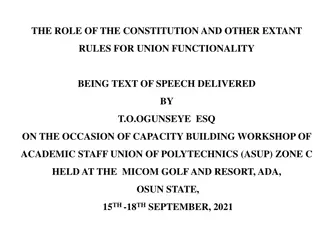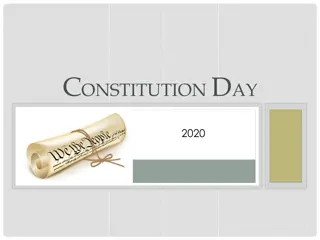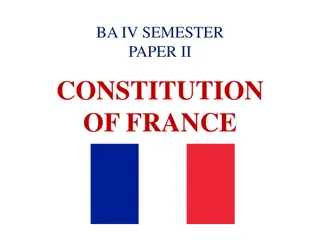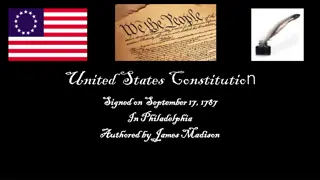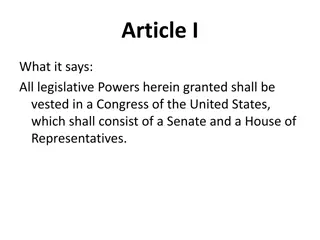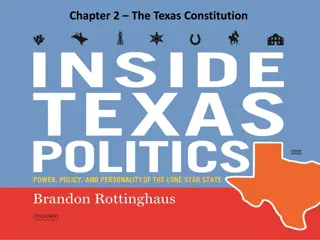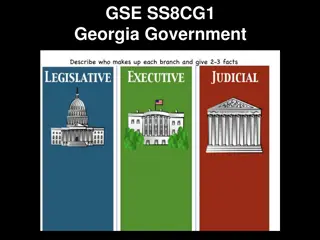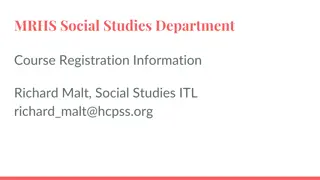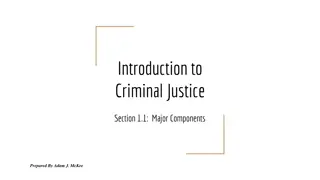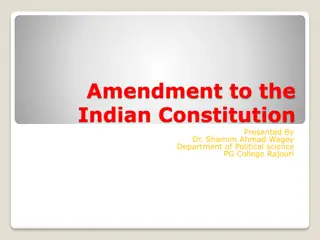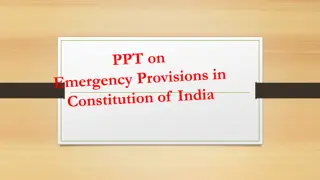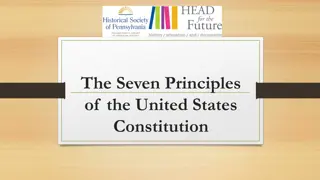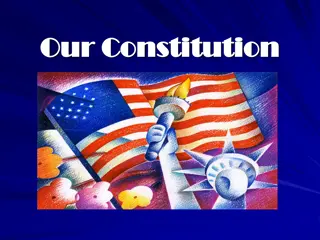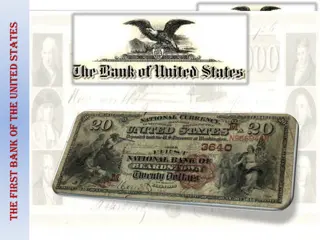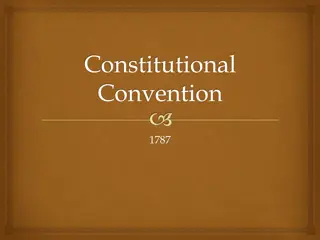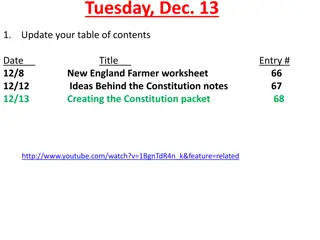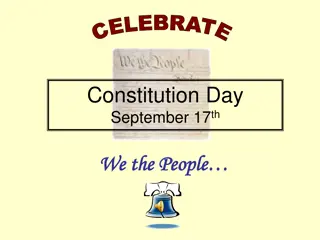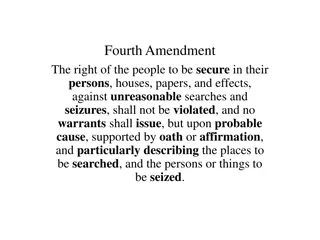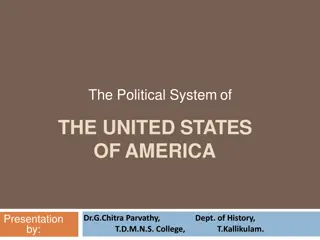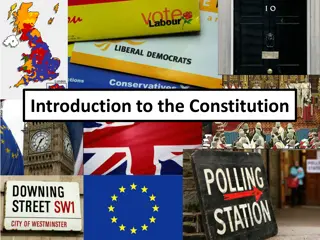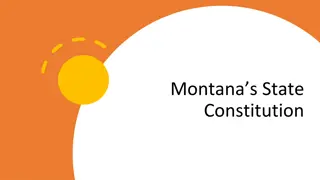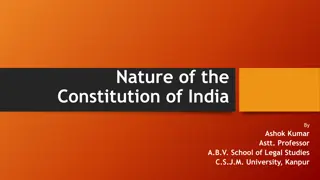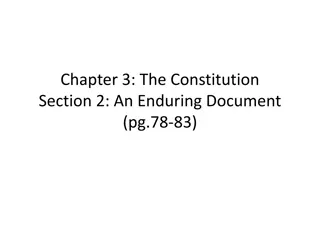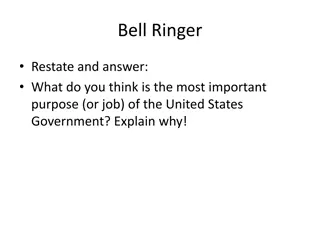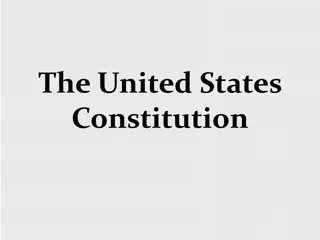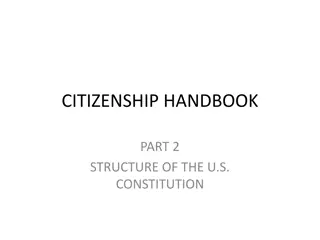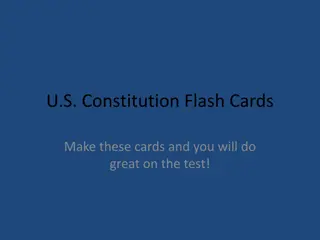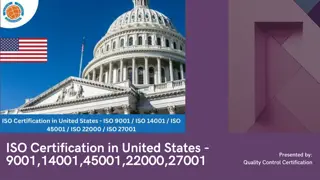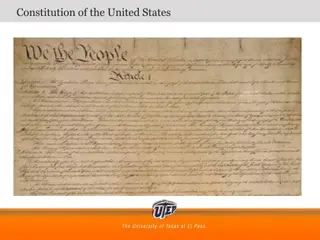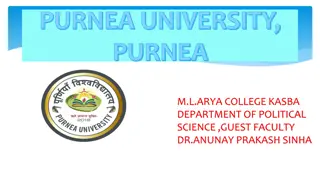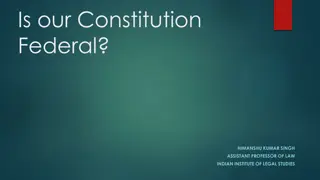Overview of Unitary, Confederal, and Federal States
Unitary, confederal, and federal states each have distinct characteristics regarding the distribution of power between central and subnational governments. Unitary states have centralized governance, while devolved states like the UK grant autonomy to subnational entities. Decentralized states trans
0 views • 22 slides
Role of Constitution and Rules in Union Functionality: Speech by T.O. Ogunseye Esq
Constitution plays a crucial role in governing the affairs of a union like ASUP, ensuring rights protection, disciplinary actions, financial accountability, and more. The ASUP Constitution outlines objectives, member rights, disciplinary measures, subscription rules, election guidelines, and educati
0 views • 12 slides
Constitution Day: History and Significance of September 17, 1787
Celebrate Constitution Day by learning about the signing of the United States Constitution on September 17, 1787. Discover the 39 delegates who signed the Constitution, the principles it upholds, and the seven articles that form the foundation of the American government.
2 views • 17 slides
Constitution of France: Salient Features of the Fifth Republic
The Constitution of France, in operation since 1958, aimed to bring stability after years of constitutional changes. It is rigid with complex amendment processes. France has a unitary constitution, a bicameral legislature, and a mix of presidential and parliamentary systems. The 5th Republic Constit
1 views • 25 slides
Understanding the United States Constitution and Federalism
Delve into the history and significance of the United States Constitution, authored by James Madison in 1787. Explore the debate of ratification, Federalist vs. Anti-Federalist arguments, and the concept of Federalism, with a focus on the balance of powers between the central and state governments.
1 views • 23 slides
United States Food Safety and Inspection Service: Ensuring Meat and Poultry Products' Safety
The United States Department of Agriculture's Food Safety and Inspection Service (FSIS) oversees the federal inspection of meat and poultry products to ensure their safety for human consumption. The statutes governing this process include the Federal Meat Inspection Act, the Poultry Products Inspect
0 views • 23 slides
Overview of United States Constitution Articles
The United States Constitution consists of several articles outlining the separation of powers among the branches of government. It establishes the legislative, executive, and judicial branches as well as the procedures for amending the Constitution and recognizing state laws.
0 views • 13 slides
Evolution of the Texas Constitution: From Independence to Modern Principles
Explore the journey of the Texas Constitution from the roots of rebellion and the Declaration of Independence to the principles outlined in the modern constitution. Learn about key events, changes in governance, and the process of amending the constitution over time.
0 views • 24 slides
Foundations of Georgia's Government and Constitution Structure
Explore the foundations of Georgia's government, including the structure of its state constitution, preamble, bill of rights, articles, and amendments. Learn about the relationship between the Georgia state constitution and the United States Constitution, and delve into the principles and intentions
0 views • 51 slides
Social Studies Course Offerings at MRHS
Explore the Social Studies department's course offerings at MRHS, including United States History for 9th grade, Honors United States History, and United States History GT. Each course provides a unique learning experience focusing on key historical themes, critical analysis of texts, and developmen
0 views • 4 slides
Overview of Criminal Justice System Components in the United States
The criminal justice system in the United States comprises various systems at state and federal levels. It consists of major components - Police, Courts, Corrections - bound by the Rule of Law and the Constitution. The Courts interpret laws and uphold civil liberties, with remedies available for vio
0 views • 28 slides
Understanding the Indian Federal System
The Indian federal system as defined by the Constitution of India establishes a unique structure where power is divided between the central government and the states. This system features characteristics such as governments at two levels, division of power, a written constitution, independent judici
2 views • 19 slides
Amendment Process in the Indian Constitution: Overview and Procedure
Amending the Indian Constitution is a crucial process outlined in Article 368. It is designed to maintain the sanctity of the Constitution and prevent arbitrary power. The process involves introducing a Bill, passing it with required majorities in both Houses of Parliament, ratifying by state legisl
2 views • 7 slides
Understanding Emergencies in the Indian Constitution
Dr. Babasaheb Ambedkar described the Indian Constitution as both federal and unitary, transitioning to complete unitary during crises. The Constitution allows for National, State, and Financial emergencies. Article 352 deals with National Emergency, where the President can proclaim it in case of war
0 views • 10 slides
The Seven Principles of the United States Constitution Explained
The United States Constitution is based on seven key principles: Popular Sovereignty, Republicanism, Limited Government, Federalism, Separation of Powers, Checks and Balances, and Individual Rights. These principles outline the foundation of the American government, emphasizing the importance of cit
0 views • 9 slides
The Signing of the United States Constitution in 1787
A group of men gathered at the Constitutional Convention in 1787 in Philadelphia to draft a constitution for the newly formed United States. Led by George Washington, they discussed, argued, and made key decisions in secret meetings. James Madison meticulously recorded the discussions while Benjamin
1 views • 17 slides
The First Bank of the United States: A Historical Overview
The First Bank of the United States played a crucial role as a national issue, highlighting the connection between financial power and control. This historical institution, established during George Washington's presidency, shaped the early economic landscape of the United States. As students reflec
0 views • 14 slides
The Constitutional Convention of 1787 and the Birth of the American Constitution
The Constitutional Convention of 1787 was convened to address the weaknesses of the Articles of Confederation and create a stronger central government. Delegates like George Washington, James Madison, and Alexander Hamilton played key roles in drafting the Constitution, which required ratification b
0 views • 5 slides
Analyzing the Creation of the Constitution
Delve into the historical events surrounding the formation of the United States Constitution through detailed notes, worksheets, and guided reading sections. Explore the key ideas behind the Constitution, the roles of various plans like the Virginia and New Jersey Plans, and the individuals involved
0 views • 22 slides
Forming the United States: From Colonies to a New Government
Explore the journey of the 13 colonies as they came together to form the United States of America. Learn about the creation of the Constitution, the fears of the founders regarding the abuse of power, and the transition from the weak Articles of Confederation to a stronger central government followi
0 views • 29 slides
Celebrate Constitution Day: A Brief History of the U.S. Constitution
Learn about the significance of Constitution Day on September 17th and the journey that led to the creation of the U.S. Constitution. From the challenges posed by the Articles of Confederation to the final signing of the Constitution, delve into the key events and figures that shaped the foundation
0 views • 8 slides
Understanding the Fourth Amendment: Search and Seizure Laws in the United States
The Fourth Amendment of the United States Constitution protects individuals from unreasonable searches and seizures by the government. It outlines the requirements for obtaining a search warrant, defines a reasonable expectation of privacy, and details the types of searches allowed without a warrant
0 views • 18 slides
The Political System of the United States of America
The presentation by Dr. G. Chitra Parvathy explores the political system of the United States, highlighting its historical development as the oldest continuous democracy. The division of powers into the legislative, executive, and judicial branches, along with the roles of the President, Senate, Hou
0 views • 13 slides
Why the United States Entered World War I
The United States initially remained neutral during World War I, but various factors led to its eventual entry into the conflict. Growing anti-German sentiments, impact of the war on the American economy, incidents like the sinking of the Lusitania, and the revelation of the Zimmerman Telegram all p
0 views • 18 slides
Understanding the Importance of a Constitution in Government
Exploring the significance of a constitution in governance, this content delves into the definition, origins, and key features of the UK constitution. It highlights the need for a constitution to establish rules for government institutions, regulate their relationships, define civil liberties, and p
0 views • 21 slides
Understanding Montana's State Constitution: Rights, Structure, and History
The Montana State Constitution sets out the principles of government, explains its organization, and lists rights that cannot be infringed. It includes the Preamble, Article I on the state's relationship with the United States, and Article II which declares rights such as self-governance, freedom of
0 views • 10 slides
A Comparison of US and Georgia Constitutions
A comparison between the US Constitution and the Georgia Constitution highlighting their preambles, articles, and amendment processes. The preamble of each constitution expresses the foundational values and goals of the people. The US Constitution outlines its legislative, executive, and judicial br
0 views • 7 slides
Overview of the Federal Structure in the Constitution of India
The Constitution of India showcases a quasi-federal system with a strong centralizing tendency, as discussed by scholars like Kenneth C. Wheare, Sir Ivor Jennings, and Dr. B. R. Ambedkar. The essential features of a federal constitution, such as division of power, supremacy of law, and distribution
0 views • 4 slides
The Evolution of the U.S. Constitution: From Jefferson and Madison to Amendment Processes
Jefferson and Madison held differing views on amending the Constitution, highlighting the balance between adaptability and stability. Despite enduring challenges like slavery, the Constitution remains the oldest written constitution. The rigorous amendment process, outlined in Article V, reflects th
0 views • 10 slides
Understanding the Preamble of the United States Constitution
The Preamble of the United States Constitution outlines the goals of forming a more perfect union, establishing justice, ensuring domestic tranquility, providing for the common defense, promoting general welfare, and securing liberty. Each goal is explained to emphasize the importance of creating a
0 views • 11 slides
Understanding the Preamble Goals of the United States Constitution
Explore the Preamble goals of the United States Constitution through a stations activity where participants discuss, define, and provide real-world examples for each goal. The goals include forming a more perfect Union, establishing justice, ensuring domestic tranquility, providing for the common de
0 views • 7 slides
The Core Purpose of the United States Government Explained
Understanding the critical purpose of the United States Government as outlined in the Preamble to the Constitution. The analysis delves into the goals of forming a more perfect union, establishing justice, ensuring domestic tranquility, providing for the common defense, promoting the general welfare
0 views • 26 slides
Exploring the United States Constitution: History and Meaning
Delve into the significance of the United States Constitution, the framework of the U.S. government. Learn about its creation, the preamble, and the core principles outlined in its articles. Discover fun facts and the enduring principles that guide the nation.
0 views • 20 slides
Understanding the Structure of the U.S. Constitution
The U.S. Constitution is divided into three main parts: the Preamble, the seven Articles that explain the government's plan, and the 27 Amendments which are written changes to the Constitution. The Preamble lists the goals of the Constitution, the Articles detail the powers and responsibilities of e
0 views • 37 slides
Financial Overview of Reductions and Contributions in the United States (2019-2023)
The data highlights reductions in the contributions of the United States from 2019 to 2023, along with the total quota income of other member states. It also includes projected expenses and budgetary reductions applied annually, categorized into personnel and non-personnel. The information provides
0 views • 5 slides
Study Guide: U.S. Constitution Flash Cards for Test Success
Explore flashcards covering key facts about the U.S. Constitution, including details about the Declaration of Independence, the Constitutional Convention, major political parties, the Preamble, goals of the Constitution, branches of government, and more. These visual aids will help you ace your test
0 views • 103 slides
ISO Certification in United States 9001,14001,45001,22000,27001
We are here to provide your business with ISO certifications that matter. Quality Control Certification guides United States companies to easily meet ISO Certification in United States 9001,14001,45001,22000,27001 standards.\n\nVisit: \/\/qccertifi
1 views • 7 slides
Influence of the Iroquois Confederacy on the United States Constitution
The United States Constitution has roots in the Iroquois Confederacy's Great Law of Peace, shaping principles of governance like division of powers, impeachment processes, and restrictions on holding multiple offices. This influence is evident in the structure of branches, war powers clauses, and ba
0 views • 20 slides
Overview of the United States Congress and Political System
The United States Congress is the bicameral legislature of the federal government, composed of the House of Representatives and the Senate. Representatives are elected every two years based on districts, while senators serve six-year terms elected at-large in their states. Congress consists of 535 m
0 views • 6 slides
Understanding the Federal Features of the Indian Constitution
The Indian Constitution exhibits a unique blend of federal and unitary characteristics, termed as quasi-federal. This constitutional setup grants power to both the center and states, yet allows for central intervention in certain circumstances. The Parliament holds authority over creating new states
0 views • 4 slides

